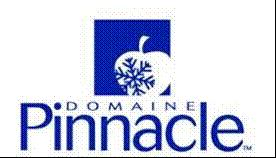In Domaines Pinnacle Inc. v. Constellation Brands Inc. 2016 FCA 302, the Court of Appeal has distinguished its own recent decision in Les Restaurants La Pizzaiolle Inc. v. Pizzaiolo Restaurants Inc., (Pizzaiolo) 2016 FCA 265 (see IP Monitor of November 2016.)
Both cases dealt with the extent to which the Opposition Board (the Board) was required to consider all possible uses of a registration in determining the issue of confusion. In the Pizzaiolo case the Court of Appeal had considered that the Board had erred in its confusion analysis by not considering the possibility of the use of LA PIZZAIOLO mark in an oval and without the formative “LA.” In Pinnacle, the Court of Appeal considered that the Board had not unreasonably concluded that there was no risk of confusion, notwithstanding the possible uses of the PINNACLES mark within the scope of the registration.
The applicant had applied for the following mark for the sale of apple-based alcoholic and non-alcoholic beverages and other apple products:

The respondents had the mark PINNACLES registered for the sale of (grape) wine. The Federal Court trial division (relying in part on the trial-level decision in the Pizzaiolo case) held that the Board had failed to consider all of the possible ways that the registered mark PINNACLES could be used. The Federal Court faulted the Board for not having explicitly considered the possible uses open to the respondents of their word mark, uses that could give their mark more of a flavour of “ice and winter,” as the appellant’s mark was characterized by the Board.
This decision has now been reversed by the Court of Appeal. The court noted in contrast to the Pizzaiolo decision that it was not the task of the Board to consider all potential and unidentified uses of the respondents’ registered word mark.
The Court of Appeal agreed with the appellant, Domaines Pinnacle Inc., that the full scope of the rights granted to the registered mark of the respondents would not permit them to use the distinctive graphic elements—the apple and snowflake design—that the Board identified as being central to the distinctiveness of the appellant’s mark. In the court’s opinion, even if the respondents choose in the future to use the same font as the appellant, the Board’s finding on the likelihood of confusion would remain a reasonable outcome, because the combination of word and design in the appellant’s mark are sufficiently distinctive. In this way, the Court of Appeal found this case distinguishable from this court’s recent decision in Pizzaiolo.
This case represents a counterpoint to the Pizzaiolo case. As mentioned in that earlier decision, the permitted variations of use are not unlimited, and a comparison of the almost contemporaneous decisions of the Court of Appeal in Pizzaiolo and Pinnacle demonstrate this. However, the scope of potential variations of a registration that must be considered when deciding the likelihood of confusion still remains more art than science. Decisions of the Opposition Board, however, will not be interfered with by the Federal Courts where those decisions are at least reasonable, in the sense of within the range of acceptable and defensible outcomes.




